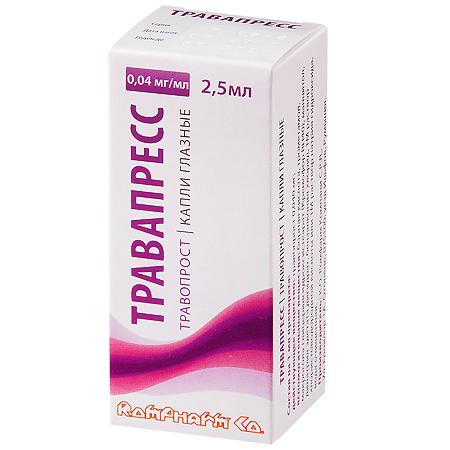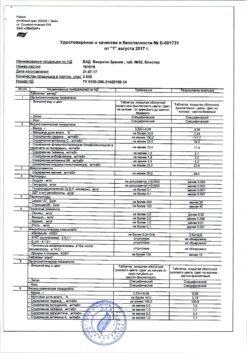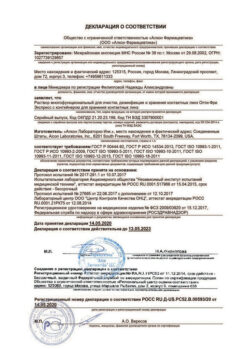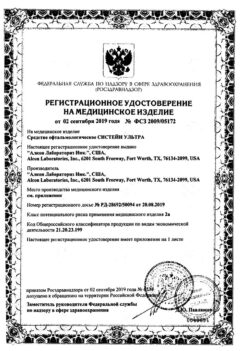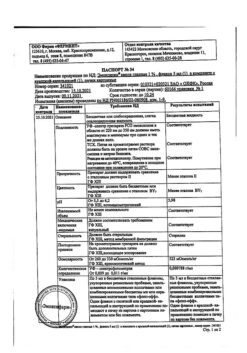No products in the cart.
Travapress, eye drops 0.04 mg/ml 2.5ml
€23.91 €19.93
Description
Elevated intraocular pressure, GlaucomaReducing elevated intraocular pressure in: open-angle glaucoma; elevated intraocular pressure.
Indications
Indications
Reduction of increased intraocular pressure in: open-angle glaucoma;
increased intraocular pressure.
Pharmacological effect
Pharmacological effect
Antiglaucoma agent
prostaglandin F2-alpha synthetic analogue.
Special instructions
Special instructions
Herbpress may cause a gradual change in eye color by increasing the number of melanosomes (pigment granules) in melanocytes. This effect is detected mainly in patients with mixed iris color, for example, blue-brown, gray-brown, green-brown or yellow-brown. This effect was also noted in patients with brown irises. Typically, brown pigmentation extends concentrically around the pupil to the periphery of the iris, and all or part of the iris may become a more intense brown color. The long-term effect on melanocytes and the consequences of this influence are currently unknown. Changes in iris color occur slowly and may go unnoticed for months or years. Before starting treatment, patients should be informed about the possibility of permanent changes in eye color. If only one eye is treated, persistent heterochromia may develop. After completion of travoprost therapy, no further increase in brown pigmentation of the iris was observed. Darkening of the skin of the eyelids and/or periorbital area has been reported in association with travoprost use in 0.4% of patients.
Travoprost may gradually change the structure of the eyelashes of the eye on which it is applied; During clinical studies, such changes were observed in approximately half of patients and included an increase in length, thickness, pigmentation and number of eyelashes. The mechanism of changes in the structure of eyelashes and the long-term consequences of this action are unknown today.
There is no experience with travoprost in inflammatory eye diseases, neovascular glaucoma, angle-closure glaucoma, narrow-angle or congenital glaucoma, and there is only limited experience in eye diseases caused by thyroid dysfunction, glaucoma in pseudophakic patients, pigmentary or pseudoexfoliative glaucoma.
It is recommended to prescribe Travapress with caution to patients with aphakia, pseudophakia, rupture of the posterior capsule of the lens, and with risk factors for the development of cystoid macular edema.
Contact of travoprost with skin should be avoided as studies in rabbits have shown transdermal absorption of travoprost.
Travapress should be prescribed with caution to patients with risk factors for developing iritis/uveitis.
Prostaglandins and their analogues are biologically active materials that can be absorbed through the skin. Therefore, pregnant women and women who intend to become pregnant should take care to prevent direct exposure to the contents of the vial. If a significant amount of the contents of the bottle accidentally comes into contact with the skin, immediately and thoroughly rinse the affected area.
Patients should remove contact lenses before instilling Travapress and 15 minutes after instillation before reinserting contact lenses.
Impact on the ability to drive vehicles. Wed and fur.:
Temporary blurred vision or other visual disturbances after taking this drug may affect your ability to drive or use machinery. If blurred vision occurs after instillation of the drug, then before driving a vehicle or operating machinery, the patient must wait until vision clarity is restored.
Active ingredient
Active ingredient
Travoprost
Composition
Composition
per 1 ml of drug:
Pregnancy
Pregnancy
Pregnancy
Contraindications
Contraindications
Hypersensitivity to the components of the drug, children under 18 years of age, pregnancy and breastfeeding
Side Effects
Side Effects
The overall profile of adverse reactions from clinical studies showed that the most frequently encountered adverse events were conjunctival injection and iris hyperpigmentation, with an incidence of 20% and 6%, respectively.
The frequency of occurrence of adverse reactions is given in accordance with the following classification: very often (>1/10), often (from >1/100 to 1/1,000 to 1/10,000 to <1/1,000), very rarely (<1/10,000), with an unknown frequency. Within each group, adverse events are presented in order of decreasing severity. Information about adverse events was obtained during clinical trials and post-registration surveillance.
System-organ class
Frequency of occurrence
Infectious and parasitic diseases
Uncommon: eye infection caused by Herpes simplex, herpetic keratitis.
Immune system disorders
Uncommon: hypersensitivity, hypersensitivity to drugs, seasonal allergies.
Nervous system disorders
Uncommon: loss of visual fields, dizziness, headache.
Rarely: dysgeusia.
Mental disorders
With unknown frequency: depression, anxiety.
Visual disorders
Very common: conjunctival injection.
Common: iris hyperpigmentation, eye pain, eye discomfort, dry eye syndrome, eye itching, eye irritation.
Uncommon: corneal erosion, uveitis, iritis, keratitis, punctate keratitis, photophobia, blepharitis, eye discharge, erythema of the eyelids, periorbital edema, itching of the eyelids, decreased visual acuity, blurred vision, lacrimation, conjunctivitis, ectropion, cataracts, crusts on the edges of the eyelids, increased eyelash growth, discoloration of eyelashes, asthenopia, inflammation of the anterior chamber of the eye.
Rarely: photopsia, eczema of the eyelids, conjunctival edema, the appearance of rainbow circles around light sources, conjunctival folliculosis, eye hypoesthesia, meibomitis, pigment dispersion in the anterior chamber of the eye, mydriasis, thickening of the eyelashes, inflammation of the eye.
With unknown frequency: macular edema, sunken eyeballs.
Disorders of the hearing organ and labyrinth
With unknown frequency: vertigo, tinnitus.
Heart disorders
Uncommon: palpitations.
Rare: irregular heartbeat, decreased heart rate.
With unknown frequency: chest pain, bradycardia, tachycardia.
Vascular disorders
Rarely: decreased diastolic blood pressure, increased systolic blood pressure, hypotension, hypertension.
Respiratory, thoracic and mediastinal disorders
Uncommon: dyspnea, asthma, nasal congestion, throat irritation.
Rarely: respiratory dysfunction, pain in the oropharynx, cough, dysphonia.
With unknown frequency: worsening of bronchial asthma.
Gastrointestinal disorders
Rarely: constipation, dry mouth, exacerbation of stomach ulcers, disruption of the gastrointestinal tract.
Not known: diarrhea, abdominal pain, nausea.
Skin and subcutaneous tissue disorders
Uncommon: increased skin pigmentation in the periorbital area, skin discoloration, changes in the structure of vellus hair, hypertrichosis.
Rarely: allergic dermatitis, contact dermatitis, erythema, rash, discoloration of vellus hair, madarosis.
With unknown frequency: itching, abnormal growth of vellus hair.
Musculoskeletal and connective tissue disorders
Rarely: musculoskeletal pain.
With unknown frequency: arthralgia.
Renal and urinary system disorders
With unknown frequency: dysuria, urinary incontinence.
General violations
Uncommon: malaise. Rarely: asthenia.
Laboratory abnormalities
With unknown frequency: increased PSA (prostate-specific antigen) levels
Interaction
Interaction
No clinically significant interactions have been described.
Overdose
Overdose
Toxicity from overdose when applied topically is unlikely. Treatment for accidental ingestion is symptomatic and supportive.
In case of local overdose of the drug, rinse the eyes with warm water.
Recommendations for use
Recommendations for use
Locally. 1 drop into the conjunctival sac of the eye (eye) 1 time per day, in the evening. To reduce the risk of developing systemic side effects, it is recommended to clamp the nasolacrimal duct after instillation of the drug by pressing in the area of its projection at the inner corner of the eye. If a dose of the drug is missed, treatment should be continued with the next dose.
Storage conditions
Storage conditions
Store at a temperature not exceeding 25 °C.
Keep out of the reach of children!
Shelf life
Shelf life
3 years. After opening the bottle, the drops should be used within 4 weeks.
Do not use after the expiration date!
Manufacturer
Manufacturer
K.O.Rompharm Company S.R.L., Romania
Additional information
| Shelf life | 3 years. After opening the bottle the drops should be used within 4 weeks. Do not use after the expiration date! |
|---|---|
| Conditions of storage | Store at a temperature not exceeding 25°C. Store out of the reach of children! |
| Manufacturer | C.O.Rompharm Company S.R.L., Romania |
| Medication form | eye drops |
| Brand | C.O.Rompharm Company S.R.L. |
Related products
Buy Travapress, eye drops 0.04 mg/ml 2.5ml with delivery to USA, UK, Europe and over 120 other countries.

